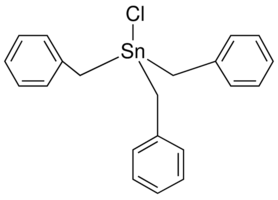In my inorganic class, we carried out the synthesis of chlorotribenzyltin, $\ce{SnCl(CH2C6H5)3}$.

The synthesis begins with a reflux I'll describe below:
In a hood, place 2.0 g (17 mmol) of 325 mesh tin powder, 4.0 mL of $\ce{H2O}$ and 6.0 mL (6.6 g, 52 mmol) of benzyl chloride in a 50 mL round-bottom flask. After the reaction mixture has been heated to reflux for 3 hours*, remove the heat and cool the flask in ice. The lower liquid phase should solidify to form a white solid.
*The white solids that appeared shortly after refluxing commenced should have largely disappeared, although small amounts of white or gray solids on the sides of the flask are usually still present. The reaction mixture at this point should consist of two liquid phases, plus a small amount of unreacted tin.
So the question the textbook asks is
Propose a chemical formula for the white solid that forms during the initial stages of the reaction of Sn with benzyl chloride.
I have a number of ideas as to what this could be:
The chloride bonded to the tin forming some kind of salt like $$\ce{SnCl2}$$
The reaction did some kind of partial reaction creating something like $$\ce{SnCl2R2}$$
The reaction went too far and created $$\ce{SnR4}$$ and $$\ce{SnCl4}$$ and keeping them in reflux redistributed the ligands based on stoichiometric amounts like $$\ce{SnCl4 +3SnR4->4SnClR3}$$
This last one seems most likely based on supporting evidence from the text:
$\ce{SnCl4}$ reactions with Grignard reagents to give organotin compounds: $$\ce{SnCl4 +4RMgX->SnR4 +4MgXCl}$$ ... (it goes on to say)...the product, chlorotribenzyltin $\ce{SnCl(CH2C6H5)3}$, is a colorless solid that is stable in air for several days. In some respects, the reaction is analogous to the preparation of Grignard reagents, $\ce{RMgX}$ by treatment of magnesium metal with organic halides.
Is my reasoning for choice 3 solid? Is there something I'm not thinking of?
